Home » Famous Football Players Who Had Hair Transplants
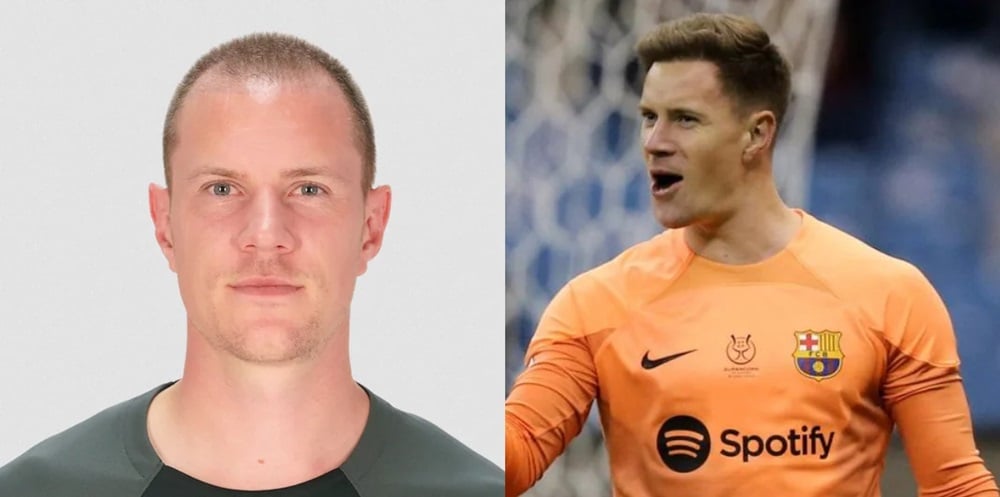
There is a stigma attached to going bald. While it remains an inexorable fact of modern life, it is particularly unpalatable for people in competitive fields. One of those is top-level football, where the pressures to look and be your best are so high as to sometimes be comically dehumanizing. Players’ appearances and how those appearances are perceived can influence their commercial appeal as well as the public’s sympathy or antagonism. Given that relationship, it is understandable when athletes go under the knife to ensure they look their best. In their own minds, they may simply be removing an obstacle to career success even if it is the sort of obstacle that one would hope humanity might one day discard.
Based on these psychological and social reasons, it does not come as a shock that the number of hair restorations taking place around the football world is growing at a frankly concerning rate. Earlier generations might have been happy to suffer in silence, trudging through their playing days mostly unseen by the public. The ink that tells the world they did indeed play has long dried for these older players, and they have the luxury of not giving a hoot about how they might have been mocked – or, worse, used as a cautionary tale. This is no longer a reasonable expectation for players in the world of today. This essay will look at hair transplants during our lives in the always-on 24-hour news cycle and work, we might presume, as a key factor in explaining how and why some stars have been able to leverage their rejuvenated follicles to make more headlines and even more money. We will examine case studies from multiple eras of world football, with special attention given to some of the most storied names from the world of English football, where baldness has for generations now been something of a litmus test for manliness and the loss thereof felt to carry existential import.
As Zaren Health, in this article, we will list the famous world star football players who have joined the hair transplant craze among the football players who have had hair transplants recently; Wayne Rooney, Rio Ferdinand, Ryan Babel, Ludovic Guily, Ter Stegen, Rivaldo Vítor Borba Ferreira, Nemanja Gudelj, Ivan Rakitic, Xherdan Shaqiri, Sadio Mane, David Silva, Pierre-Emerick Aubameyang and Loris Karius. Let’s take a look at the before and after hair transplant images of the football players together.
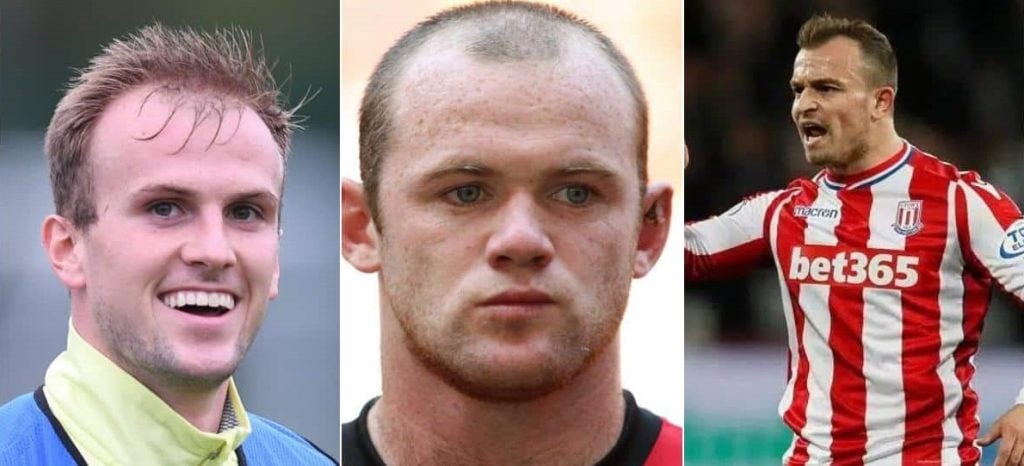
The number of football players having a hair transplant could reportedly fill a referee’s notebook, with sports news desks buzzing with news of more head-to-head hair restoration action almost weekly. Footballers’ on-field scalp work closely reflects what’s happening off-field, and if 8,000 hair restoration procedures are carried out worldwide each year, it’s apparent that the hair transplant business is booming. Both men and women increasingly want to look youthful. Longevity experts say 40 to 50 is the time to begin preserving your appearance if you want to retain a youthful look well into old age. Footballers are right up there with other celebrities as fashion ambassadors, and their desire to hold back the years is replicated in the hubbub of headlines, blogs, and search figures for those players who also choose hair surgery to restore a youthful head of hair.
The foundations of modern hair transplantation were laid down in the U.S. in the late 1950s during the pioneering work of a dermatologist. The doctor was later to perform hair transplant procedures on many celebrities and the wealthy of society. Over in the UK in the 1960s and 70s, when wigs adorned the heads of hirsute heroes and film stars, hair transplants and wigs were viewed as the last refuge of the man with a disappearing follicle. However, the tide has turned, and hair loss has become a formidable enemy in the attacking formation of the League of Extreme Vanities. Difficult but not insuperable, the strategy needs to have a multi-pronged approach. A string of U.S. surgeons are employing an array of new high-tech weaponry; the buzz of insightful blogs both by the patients and the new era of web-savvy and very passionate hair doctors. The new wave techniques include FUT, FUE, ARTAS Robot, and the newer hair multiplication procedures. In contrast to the 1950s-1970s when the pioneering doctor and his colleagues would remove narrow columns of skin from the back of the head to replant on the balding patch to disguise these ‘plugs’ better, more adept and refined hair surgery like FUE provides more natural results. Furthermore, the shorter recovery time and post-operative pain make it a double plus point for professional footballers and sports personalities. Several remarkable achievers in the football industry understand the essence of looking good to feel good and perform great. It is not just for the players; it also becomes quite an important aspect for football managers, team directors, and professionals to look calm, controlled, and possess an appeal of integrity to use their physical appearance in their job. The relentless media scrutiny nowadays does not help the case, and hence medically, a variety of professionals avoid the hair transplant scar, the unnaturally looking ‘hair plugs,’ and try to maintain the discretion afforded by a natural hairline and natural-looking hair. Using the employment of the new modern hair transplant techniques that offer a natural feel, hidden donor scar, and close crop haircut without the dread of lost hair or having the surgical hairline set a few inches too low, which looks so bad when you are 60 and have remaining locks as well.
The question of personal appearance was rarely discussed in the context of a sports career before. However, the historical background of hair transplants in football could provide a nuanced understanding of the problem. When asked about his favored methods of hair restoration for soccer professionals, a dermatologist praised a number of “elite footballers” from Great Britain who openly discussed their hair restorations. While hair transplantation has been in use since the mid-20th century, early treatments were not very effective and led to the method being deemed fraudulent. As a result, there is a real sense in which hair transplants in sports are new, marking a sea change in the industries of surgery, hair care, and sports celebrity. An interview with a notable figure corroborated this assumption, showing the skepticism surrounding hair transplants two decades into their use. It was not until a group of non-famous men received national attention for their surgeries that a few doctors began to cautiously recommend a newly approved method for restoring hair: punch graft transplants.
Modern-style hair transplants have been underutilized. However, hair care providers actively worked to create visual and scientific goodwill for the procedures. Positive press was crucial for their acceptance. The history of hair transplants in soccer becomes especially notable as the twenty-first and twenty-second centuries progress, wherein individual athletes sought reputational benefits from playing into an emergent discourse around personal grooming.
Technological advancements in hair transplant surgery have made it an appealing option for professional athletes. The FUE (Follicular Unit Extraction) method is a huge leap forward in terms of being minimally invasive. There are no longer any stitches, scalpels, or incisions. This used to take a few months to heal, and footballers were often embarrassed to go to the pitch because the lengthy downtime meant that they were unable to return due to being self-conscious about their appearance. It typically took seven to ten days. Many bald footballers would fly to have FUE surgery during their longer mid-season breaks because of these issues. Many player managers questioned the notion of a footballer having medical techniques in another country. This is because when these players returned, some of those same sports managers could not believe how fast they could return to their professional duties. FUE doesn’t require a lot of recovery time because the incisions in the donor region are so tiny. This has opened up another technique of hair transplant to the players’ agents.
There has been a rapid technological improvement in the grafting instruments and devices used for FUE. For example, the older FUE technique required a manual punch to manually score each follicular unit. As a result, if the surgeon needed 2,000 grafts for a major hair transplant operation, this would take many hours to complete the scoring process alone! Now imagine having to expend hundreds, if not thousands, of hours just cutting tiny areas for the transplant grafts on a huge surface of a balding footballer’s scalp! In addition to enhancing the level of hair loss treatment for male athletes, all of these advancements also improve the visual aspect of the hair transplant. Footballers are more likely to have successful hair transplant procedures if they have a good aesthetic result. The role of the aforementioned surgeons within professional sports communities is also significant. If a physician is unable to work as a medical provider for a professional sports franchise, they must also have the patience required to work with elite sports competitors. Screenings and positive physician/surgeon recommendations have led to being inducted into, and remain, a treating physician for several professional soccer clubs. This has given the opportunity to notify football agents about such technology that prevents them from worrying about the recovery time and an unsightly look. Many prospective professional footballers question why they would try something like FUE if they were bald, only to be shocked and excited by the answer to the question. In the past, professional athletes would refuse to participate in traditional hair transplants due to the lengthy recovery period imposed by the incision along the back of the scalp, in particular.
In 2011, Wayne Rooney – then Manchester United’s number 10 – tweeted a photo of himself while a paper spacesuit sat atop his head. ‘My head is melting,’ he captioned the image. The previous day, Rooney had undergone a hair transplant. Worldwide headlines later spoke of the inspiring effects of this procedure on his career. Since then, numerous high-class footballers have turned their plight into stories of success following surgery for hair loss.
Ashley Ward, a top-tier English footballer turned manager, was happy to learn that a character introduced to some fans as a balding man was thereafter met with comments such as ‘Respect to Ash for the hair’ – not least because catering to appearances has become somewhat a matter of life and death for modern Premier League footballers. It wasn’t until 2012 that members of the medical committee of world football’s ruling body defined football’s ‘pathological obsession’ with hair transplants as one of the sport’s biggest superstitions. This, in light of many allegedly resurgent glass skies, was again met with positivity upon every goal, overthrowing skeptics with every ‘becoming of oneself’ through renewed behavior. Perhaps relatedly, Liverpool goalkeeper Loris Karius also underwent hair transplantation ahead of his loan deal at Bundesliga club Union Berlin. He has since reiterated homages to rebranded perceptions of inconvenience.
Former athlete Wayne Rooney is an English football legend known for his time playing for notable teams like Manchester United and England’s national football team. Over the course of his career, he made headlines as much for his athletic prowess as he did for his experiences with hair loss. In 2011, Wayne Rooney became the subject of public ridicule and scrutiny when a British tabloid released a photo and an article detailing how the athlete had already gone bald by the age of 25. The headline reads “England star Wayne Rooney looks like Becks – after first having his barnet replaced.” The article’s overall tone mocks Rooney for being a lookalike and expresses doubt as to whether Rooney got “value for money” from his first hair transplant. Though Rooney was open about his struggles with hair loss in interviews on and off the field, he chose not to engage in hair restoration until his late twenties. A few years after the initial intense public interest in his hair transplants, Wayne Rooney began boasting about the procedure on his own account, publicly confirming that he went under the knife for the final time in 2016.
Wayne Rooney underwent a FUE hair transplant, with 4000 grafts implanted. The technique utilizes a sapphire blade to make incisions on the scalp delicately. These incisions serve as the ideal spots for placing hair grafts.
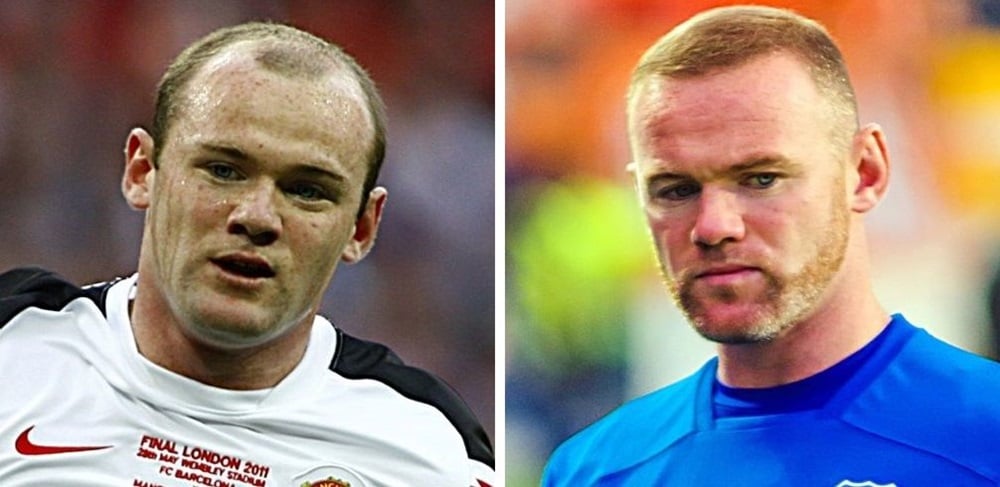
Wayne Rooney looked like this before and after his hair transplant.
Rio Ferdinand was one of the first footballers to openly undergo a hair transplant, and it transformed his image – both off and on the pitch. He first spoke about his experiences with hair loss in 2007. “I first noticed my hair thinning when I was around 25-26 years old,” he explained. “I was in the England squad at the time. That was the first time I could see it was kind of getting a bit thin on top. I first shaved my head in 2009 and that’s when I realized it was time to do something.
Rio Ferdinand underwent a FUE hair and beard transplant, with 1000 hair and 850 beard grafts implanted. The technique utilizes a sapphire blade to make incisions on the scalp delicately. These incisions serve as the ideal spots for placing hair grafts.

After quitting football, Rio Ferdinand wanted to regain his lost hair and gained a new look with hair transplantation and beard transplantation.
Ryan Babel is a relatively unique example in the case study as an athlete who decided to undergo a hair transplant while still active as a player. The footballer, originally from Amsterdam, began losing his hair earlier in his career, leading to considerable speculation in the public domain. In a press interview, Babel’s former Merseyside Derby teammate acknowledged that, because of Babel’s hair loss, “a lot of people have written big stories about that and it gets a little bit of attention and it got a little bit of attention off the field — none of it was nice, I’m sure.” After undergoing hair restoration surgery, Babel spoke up about his experiences.
Babel’s hairline throughout his career had been a point of consternation. His thin-on-top/balding look confounded the conventional wisdom that fast, young athletes should radiate a spritely vigor and full-bodied vitality. So after the procedure, his former teammate could easily sense the change in attitude towards Babel. “But I love this about football. Ryan Babel has scored twice this week for Galatasaray against Rizespor,” he informed while introducing the story. “He’s doing well out in Turkey, and I think he’s even more confident now he’s had a very subtle little hair transplant.” Babel has also posted about the success of the surgery on his social media profiles, offering interviews about his procedure, and following up regularly on his own pages, where he shares images and videos of what the surgery and recovery were like. His former teammate, meanwhile, has hailed the transformation of the footballer as a PR-friendly advent, one that would “open up” the life of Babel while allowing others to “come out” and participate in the social media narrative of changing their hairlines and hairstyles. In this respect, Babel’s story is an example of how athletes are getting younger — as Babel’s transplant occurred while still in his prime and active in football — and only continue to shift hegemonic gender scripts that maintain hair loss as a natural sign of masculinity.
The Sapphire FUE technique uses a sapphire blade to create precise incisions in the scalp. These incisions serve as ideal points for the placement of hair grafts.
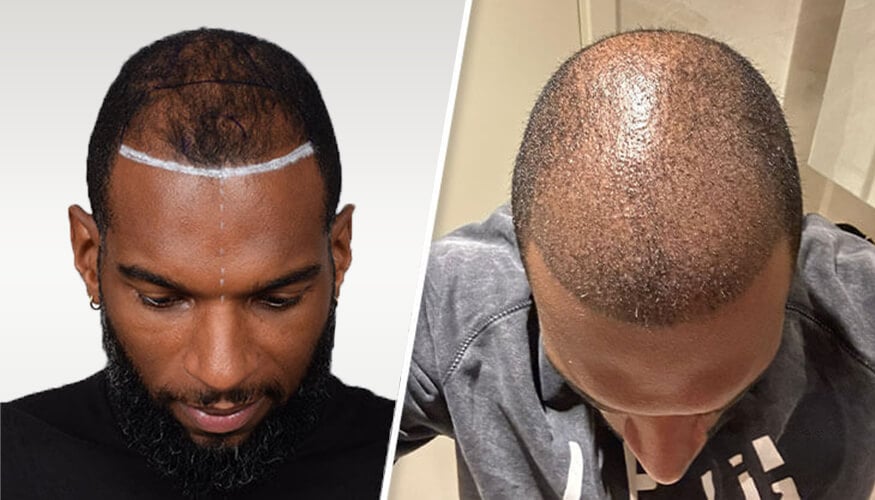
Dutch star Ryan Babel, former football player of Galatasaray, gained such an appearance after Afro Hair Transplant.
The notion that hair transplants can define a player’s career, as it wends its way through society and judgment, becomes evident when we talk about Giuly. If we were not talking about these “expensive” details, we would not be discussing these aspects. The accelerated transformation that soccer has just experienced in society shapes the reception of Giuly’s hair transplant. How many of you remember Ludovic Giuly? A little French blond guy with footballing talent that peaked around the mid-2000s, when he won the Champions League with Barcelona. He also won a World Cup but was not in the public eye nearly as much as he could have been. Truth be told, he advanced in years when his career put him in European obscurity, toasting away in the blissfully forgotten corners of Bucharest.
The thing about Giuly is that, after his playing days in the bright sunshine of the Camp Nou, he retreated to Romania when his career was pretty much done. And there, all of a sudden, he showed up in the public sphere once more. And he looked a bit different. When Ludovic Giuly retired, it was as a tanned, burly man of 37. It was expected he would lose some hair; it was both shocking and fatigue-inducing to watch him transform into an apparently balding man over two years. This was still a rich professional athlete who decided to get hair transplants; he might as well give this thing a go and see if it works. And guess what? It did; his new, glistening locks rekindled his public identity. “Oh, well, Giuly was never balding,” people said, in a sort of collective denial. “Looking good, Ludovic!” struck the next logical step for the fans of the team and league that Giuly was playing in. After the public had finally come to terms with the head of hair that would envy many, Giuly found himself back in his roots, namely French Ligue 1, at the modest visage of AS Monaco.
Ludovic Giuly underwent a FUE hair transplant, with 3450 grafts implanted. The technique utilizes a sapphire blade to make incisions on the scalp delicately. These incisions serve as the ideal spots for placing hair grafts.
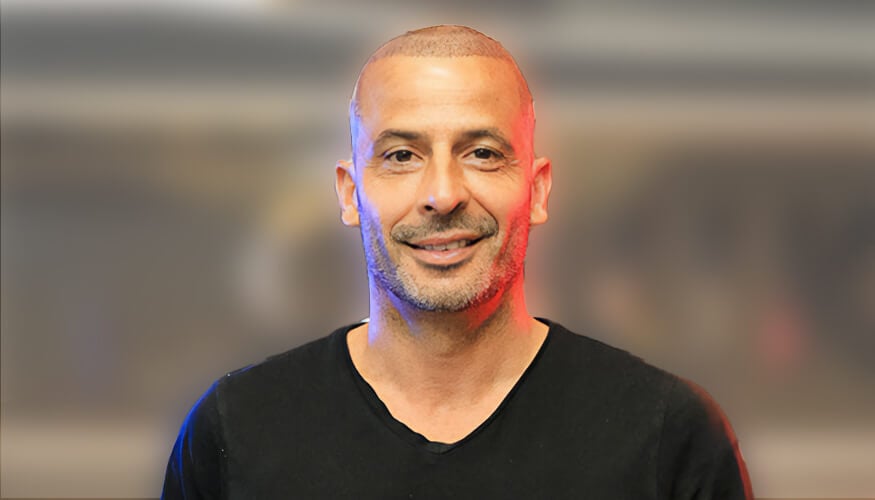
If there is an attribute that sets Marc-André ter Stegen apart from his colleagues and opponents, it is his insecurity. Every goalkeeper may have their ups and downs, but the German goalkeeper can confront players and people head-on when he is in full touch. Even when he is in touch, there is slight uncertainty that continues to shine through. We breathe through their ACL tear too, and we understand how delicate he can be when he’s away from the field. In this global age of social media, images are as important as actions. Besides the response to his physical meetings and his speech, ter Stegen had to come to terms with another issue: his hair loss. Like a majority of people, the then 25-year-old’s curls were steadily going down his forehead. His hair was serving as a crutch for self-acceptance and self-confidence that someone who performs at the top of the game needs in his professional life. When you participate for Bayern Munich, Barcelona FC, and your national team, amongst others, it’s all the more dreadful. He eventually had a hair transplant. Not only did his new hairline beam with excitement at the change in his life, but he transformed his strategy in life too.
Ter Stegen underwent a FUE hair transplant, with 2500 grafts implanted. The technique utilizes a sapphire blade to make incisions on the scalp delicately. These incisions serve as the ideal spots for placing hair grafts.

The famous German football player experienced an incredible transformation after a hair transplant. Ter Stegen’s before and after images caused a great stir after his hair transplant. Stegen, who has thick hair after the hair transplant, is very happy with his new appearance.
Rivaldo Vítor Borba Ferreira, or simply Rivaldo, to the general public, like other cases already discussed, is another illustration of the use of hair transplants in football. As one of the best-paid forwards, former players, and a striker who won the World Cup, he was expected to look perfect. However, along with an illustrious career, Rivaldo struggled with hair loss. In his mid-to-late 20s, before leaving for Milan, signs of androgenetic alopecia became more apparent. A further decline was seen during international clubs’ spells in Greece and Central Asia. Rivaldo’s move from Europe to Africa signaled his indirect admission of the current situation. To take a breath from the hustle and bustle of professional soccer, and implicitly inactivity—but most likely by conducting almost imperceptible, painless hair restoration—Rivaldo went to Africa. After his return, in November 2009, he adopted wearing hats and scarves even indoors and used a discreet haircut to mask hair loss, clearly avoiding baldness at public events; Rivaldo had never been addicted to exaggerated hairstyles and is known for his conventional look.
Rivaldo underwent hair restoration to fill in a pre-existing but worsening pattern in the frontal-anterior zones. He also had mild, slightly sparse receding temporal peaks. Rivaldo had no hair on the top of his head, with no center part, which made exactly two procedures feasible; there was no need for a third session. This was not only thanks to aggressive enough treatment at the front but also, in theory, aggressive enough in the mid-scalp of the first procedure to ensure the second procedure at a higher density of a supposedly virgin scalp can join them to create one honeycomb of coverage.
Rivaldo Vítor Borba Ferreira underwent a FUE hair transplant, with 4000 grafts implanted. The technique utilizes a sapphire blade to make incisions on the scalp delicately. These incisions serve as the ideal spots for placing hair grafts.
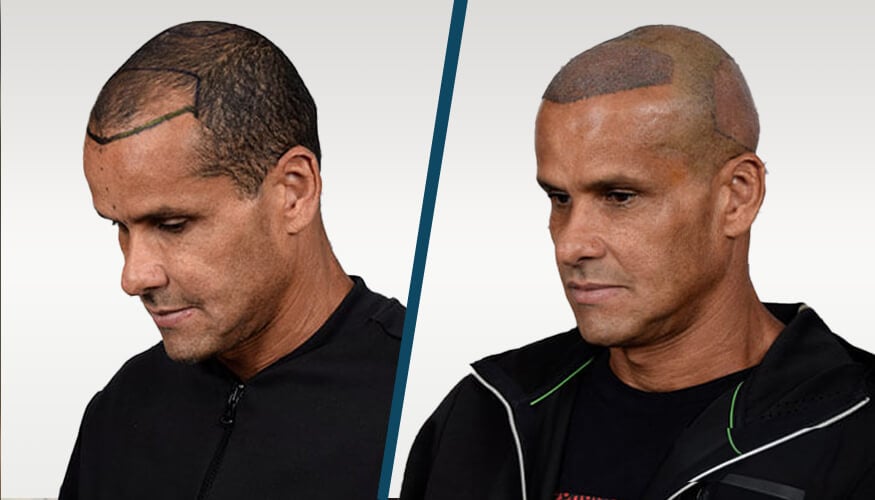
Brazilian football player Rivaldo became 10 years younger and had a new look after his hair transplant. Rivaldo’s transformation was impressive.
By the time Nemanja Gudelj had his procedure in the spring of 2018, he was only 26 years old. For athletes, the age of 26 is still relatively young. Still, men can start losing hair quickly as they get older. There is also a lot of criticism among young football fans who are bald at a young age. Gudelj wanted to rule this criticism out as much as possible. He knew he might not have lit the candles just to convince his listeners that he was still in good shape. In addition, the primary goal of the hair transplant was not so much the way he looked, but to recover his confidence. With a beautiful head of hair, he also looks his age. And he still has many years to shine. “I notice that it has given me confidence. It is not scientific; it was more the feeling. I am still just as young as all those boys, often even younger,” said Gudelj. “But you also see it on other players; people always talk about their appearance. Each time he gets a new hairstyle.” That proactively having something done to your appearance is also a professional choice. “Hairstyle has been an important motivator for this procedure.”
The role of personal appearance is not always well understood by the general public, especially when it comes to professional athletes. While grooming and appearance are to be expected from players in many other sports, this is not always the case in football. Gudelj said he was not afraid of the reactions of fans: “But that was not important to me. It was from people who were close to me, and they understood. They hadn’t seen me like this.” “I think I came back from the World Cup and I was immediately in the media and facing failures. But that is because I like to show myself confidently.”
Nemanja Gudelj underwent DHI and Sapphire FUE hair transplant, with 3500 grafts implanted. The technique utilizes a sapphire blade and choi pen to make incisions on the scalp delicately. These incisions serve as the ideal spots for placing hair grafts.
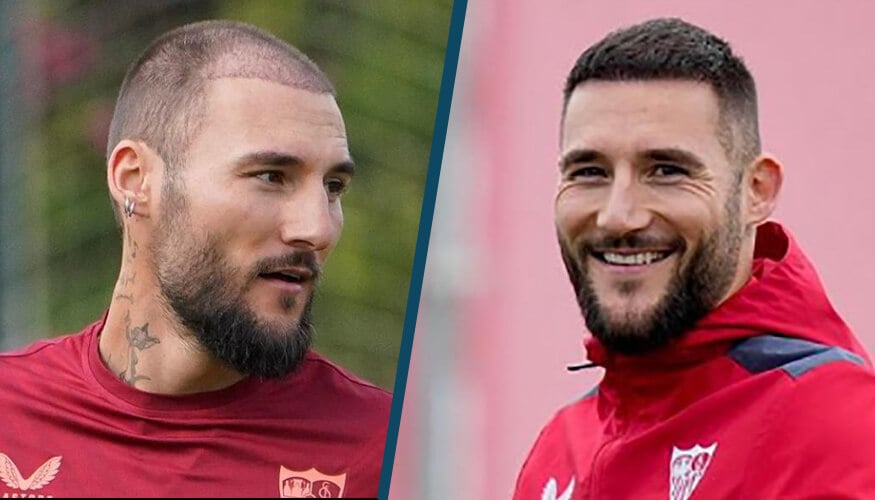
The successful star of the football field, Nemanja Gudelj, has a new look after a hair transplant. The star football player, whose appearance is documented with before and after photos, is now happier with his new hair.
During Ivan Rakitic’s time at Sevilla and Barcelona, one moment stands out: On December 7, 2013, he scored a stunning overhead goal that helped Sevilla beat Athletic Bilbao 2-1. Rakitic’s first touch thrilled onlookers because it led him to find the angle he needed. In Bilbao’s response, the head of the Croatian hero forcefully hit the scoring frame. Rakitic was a technical all-rounder. Nevertheless, he faced a particular problem at the top level. After migrating from Schalke to Sevilla in 2011, his hairline receded. Every season, it was climbing further, and at Barcelona, in the most-watched tournaments, it decided to accelerate Rakitic’s preparations to radically shift the profile of a public person. The Croatian chose the first cloudless window of professional holiday to expand his hair follicle, doing so six months after scoring Sevilla’s beautiful winner in the 2017 Spanish Cup final.
In football folklore, financial constraints and anatomical limitations cement former players surpassing the luxury assets of modern predecessors. Sparse significance is attached; personal appearances become central. Parallel discussions dominate the panel of hair-loss specialists and popular entertainment platforms. “Rakitic’s long hair was his trademark,” said his agent. “His hair gave him more than 1% confidence; it increased his self-confidence and gave him a sense of well-being.” These are intriguing findings when you consider that Rakitic’s commitment to cosmetic appearances has been turned down critically, presenting a slope endangering the prevailing figure in masculinity: Prestige. Based on some historical context, a forward-looking wish is driving many professional footballers’ privacy patterns. In Spanish sports, a significant portion of soccer broadcasting consists of talk shows. Topics include games, coaching strategies, and referee judgments, with semi-profile appearances also available. Standard society is rarely discussed. Traditionally taboo, athlete admiration is gradually receiving greater positive encouragement.
Ivan Rakitic underwent a Sapphire FUE hair transplant, with 3000 grafts implanted. The technique utilizes a sapphire blade to make incisions on the scalp delicately. These incisions serve as the ideal spots for placing hair grafts.
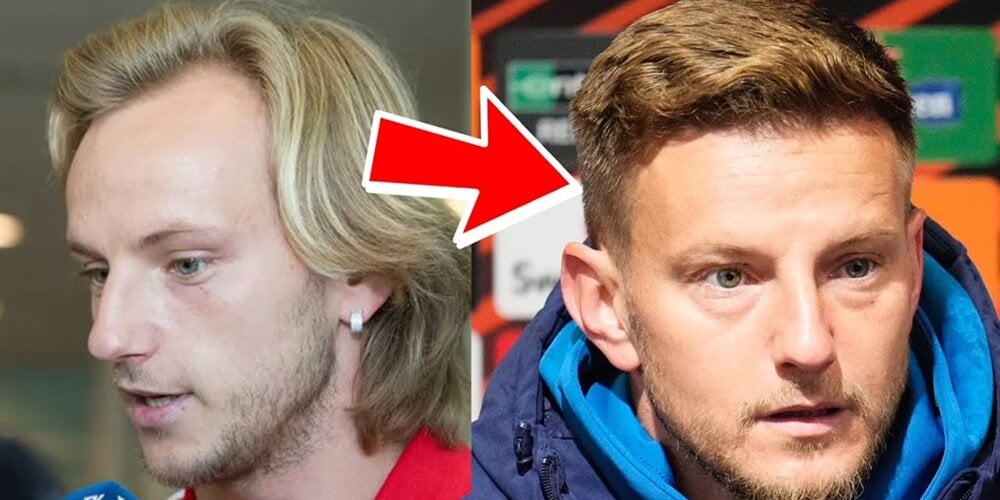
Ivan Rakitic’s transformation has also inspired other football players. Ivan, who had a successful hair transplant operation, dazzled with his thick hair. You can also take a look at Rakitic’s before and after hair transplant photos.
In the summer of 2015, Xherdan Shaqiri moved to Stoke City. He was 23 years old, world famous, single, and endorsed by various international brands as a pin-up boy. He was also well on his way to becoming quite a different sort of pin-up boy. In his early 20s, the Swiss international was diagnosed with alopecia – an autoimmune disorder. Stressed and fearful, Shaqiri was informed that every single hair on his body could, in this context, fall out. After having paid for a special surgery with a strip of material taken from part of his head that never falls out, since replaced with hair grown inside a lab, Shaqiri has been totally cured of alopecia and never worries today about it coming back. His scalp still displays the shimmering scars of the ordeal.
At the most fundamental level, Shaqiri’s re-made look does reflect a fighter’s attitude to visual oppression, albeit one which ultimately speaks much about the changes that have transformed the on-and-off field landscape in football, from Shaqiri’s teenage years to his warm, deep-throated prime. Societal norms, particularly with regard to male grooming, are relaxing. Across the Western world, a luxuriant beard works as well as a megawatt smile, and still sends out messages of manhood, stability, and strength. Acceptance has finally been checked by, in some quarters, backlash and wariness. Most of Shaqiri’s fans, though, have had no choice but to acknowledge the transformation, and indeed, come to celebrate it once it took place. His looks are now a main topic of conversation on a weekly basis among locals in bars and cafes. Even when he signed with Roma in January 2022, the final comments were about his hair rather than any on-pitch activity. Shaqiri, who has scored six goals in three appearances for the team, has admitted that the transplant changed his mental approach significantly. “My level of confidence is very high thanks to my new look,” Shaqiri said following a win. “I feel liberated, and it is noticeable in my overall success as well.”
Xherdan Shaqiri underwent a Sapphire FUE hair transplant, with 2500 grafts implanted. The technique utilizes a sapphire blade to make incisions on the scalp delicately. These incisions serve as the ideal spots for placing hair grafts.
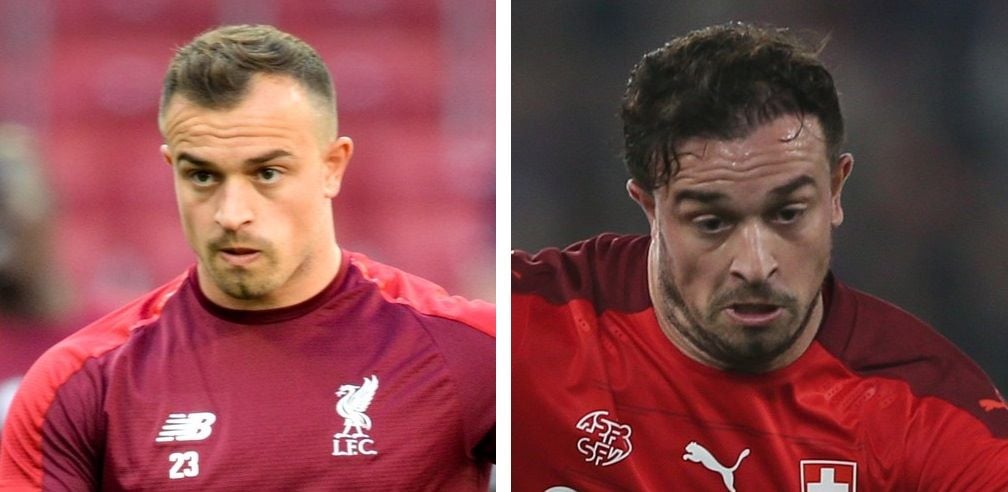
The successful Swedish football player showed everyone that he has experienced an incredible transformation with his before and after hair transplant photos. Xherdan Shaqiri’s new hair is dazzling.
Idolized for his remarkable skills, Sadio Mané faced increasing pressures concerning his appearance but stubbornly disregarded them until his former club manager commented on his lost locks. Mané initially questioned the relevance of personal grooming in the heat of a match. Nonetheless, a larger portion of the club’s backroom leadership team quickly interviewed and signed him. The then-22-year-old agreed to a 10-hour-long transplant the morning following his fourth round of talks. A month to the day following his procedure, he scored a fourth-minute goal to help secure his team’s victory in a European competition. Since his decision to restore his hair, society’s depiction and acceptance of the male athlete’s pursuit to look his best have changed. Mané’s public involvement in a service that was once deemed hush-hush has progressed into an unspoken, unofficial endorsement of his transplant surgeon.
As manager Jürgen Klopp once testified, potential new stars inquire whether a hair transplant might assist them in outcompeting others for a squad place. Given Mané’s eagerness to appear in public with his hairline slowly reappearing and then immediately regrowing, it was a course of action he unhesitatingly made plain to people. In admitting to having undergone follicular unit extraction to rectify his receding hairline, he poignantly improved himself. His positive acknowledgment of having had things ‘done’ demonstrates the shift recently taking place regarding present-day players and women. During that time, many participants have heeded the advice, choosing as always to look upon Mané’s example. Although predominantly aged from their early to mid-twenties to mid-thirties, a considerable majority of those with whom we have met are planning to spend at least the next five years actively competing in professional adult leagues.
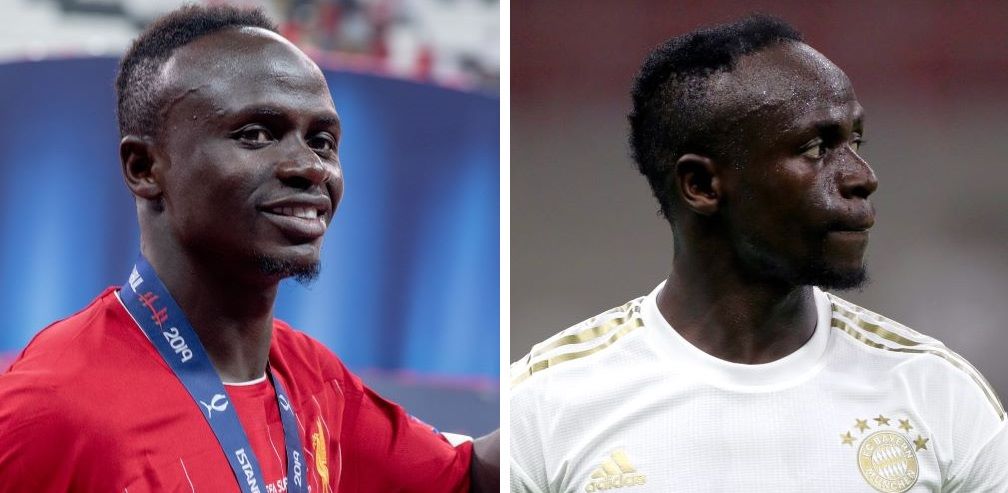
Sadio Mane has joined the ranks of footballers who have had hair transplants. He continues his football career successfully with his new look.
David Silva is well-known for his incredible skills – he excels at every level and is the quintessence of a footballing superstar. In addition to being known for his game, football fans attribute his status to his appearance. He surprised his followers by getting a hair transplant. Through his narrative, one can better understand the complex personal calculations that top-level footballers, and arguably elite athletes generally, make regarding the choice and implications of aesthetic interventions – beginning with those concerning the look and feel of his scalp. After several years of denying rumors of having a hair transplant, Silva finally came clean in an interview about getting one. He began to endure what he called ‘jokes’ from his friends about his hair loss. He laughed along with them but admits that the jokes ‘aggravated’ him. It was at this point that Silva began to question himself and eventually sought out a surgeon to change his appearance.
When questioned about the appearance-altering aesthetic medical practice, he answered: ‘You can do one. No problem.’ He revealed that he underwent the first transplant surgery when he was 19, getting a second one at the age of 29. These interventions in personal appearance ‘not only restored his hairline, but also his self-confidence.’ A final question aimed to draw him out on his mentality and investing in personal appearance. Regarding his grooming – his careful facial and scalp practices but also his fashion sense – he feels good about himself ‘both inside and out.’ The ‘how you look’ element, Silva stated, is ‘important in football.’ How you look can have an influence on how you play. The grooming investment he makes in large part goes to ‘my own good,’ creating more ‘self-confidence’ and ‘a nice feeling around training, which then takes into the games.’ Although he has regretted getting ‘bad hair,’ a ‘bad image’ that happens to other people, on occasion, they ‘don’t look after it.’ By contrast, ‘I have always tried to look after myself.’ His intentional management of his personal grooming sends a message to onlookers.
Since Silva’s revelation, fans tease him and sing songs about his bald spot, but how he appears to see his grooming as a professional investment influenced not only public responses but also media reactions to his treatment. Grooming interventions, in particular hair transplants, can be explained away so that they have ‘no implication of professional privilege.’ His hair transplant is ‘the secret of his longevity in the Premier League,’ one headline read. It was said, ‘He made his hair earlier than those of them – David now has good hair.’ in a press conference to stave off criticism of Silva’s performance on the pitch. The statement that his hair transplant is ‘the secret of his longevity’ plays down the privilege aspect of such grooming interventions since it has become for them as ordinary and necessary as getting a haircut. Moreover, the message is perhaps meant to be that players are expected to make additional investments in personal pre-match management. The statement resonates with personal sources showing that ‘players in the Premier League have hair transplants before the new season,’ with the final weeks of the close season often referred to as the ‘hair transplant period.’ Equating hair transplants with pre-match appearance management, his treatment, despite fan position effects, reveals, is normal rather than exceptional; it is good if hair transplants give professional players ‘extra confidence’ more generally, more players should consider them. In this regard, having a hair transplant shapes Silva’s professional identity ‘as another form of conspicuous body modification’ considering that fan responses reveal its relevant grooming aspect.
David Silva underwent a FUE hair transplant, with 2500 grafts implanted. The technique utilizes a sapphire blade to make incisions on the scalp delicately. These incisions serve as the ideal spots for placing hair grafts.
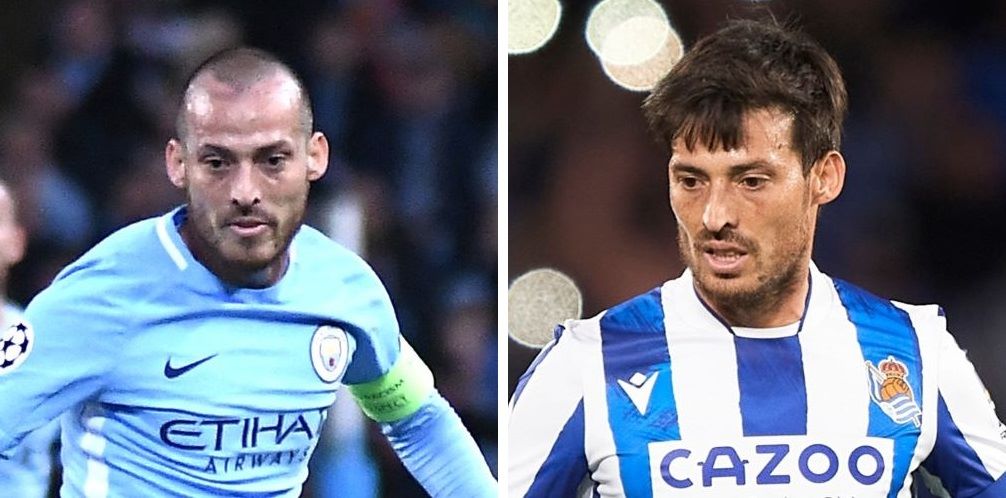
Famous football player David Silva is one of the football players who had hair transplants and achieved successful results. David Silva became the owner of thick hair after hair transplantation. Before and after photos clearly reveal this situation.
When you’re a Liverpool goalkeeper, every action is scrutinized, including hair. Loris Karius, who is now on loan to Besiktas, has undergone a hair transplant. The message is loud and clear: I am currently lacking. Embedded among sporadic appearances for German superpower Union Berlin and contract negotiations—his Liverpool deal expires in 2022—Karius was able to take a quick trip to the hair clinic. Karius is now sporting a comically large headband and smiling groggily just a few hours after his head’s 3,000 hairs had been reconstructed. I’m told that Karius made fun of it. And, after all, why shouldn’t people laugh at his hair?
Image and persona are the best methods to protect yourself. Integrity can be preserved in a standardized employee event, for example. Rule number two: change your hair to convey a new and confident vision. Liverpool, after all, does not need an insecure player. Karius was terminated the following day for various reasons. Red added the blues in his eyes when he scored against Milan in a Europa League final. A year and a half later, fellow countryman Brendan Rodgers replaced him with “one of the finest goalkeepers in the world,” stating that Alisson’s deal had begun. He had already accumulated more than 200 appearances at nine European champions before he began. Such hypertensive highs and lows, among other things, cause hair loss. Managers check out when this kind of scoring is on display. Some of his admirers viewed his transplant as a hopeful indication of progress. The consensus on social media is that it is permissible to actively modify one’s destiny. While Karius was encouraged by the floods of aid, many internet users were perplexed by the goalkeeper’s intentions. Why exactly, if you’re a professional athlete, would you want hair?
Loris Karius underwent a FUE hair transplant, with 2000 grafts implanted. The technique utilizes a sapphire blade to make incisions on the scalp delicately. These incisions serve as the ideal spots for placing hair grafts.
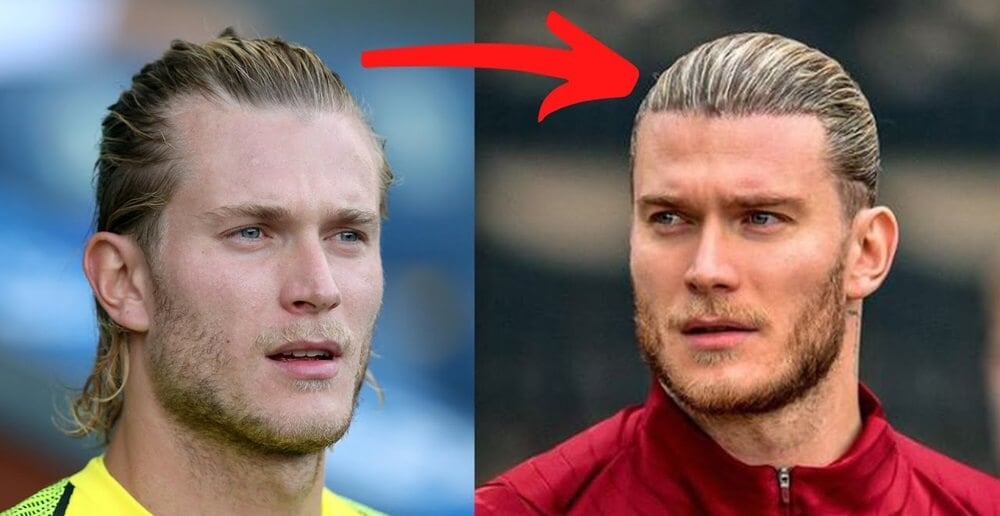
Loris Karius, who has been experiencing sparse hair loss, took his place among the footballers who had a hair transplant. The goalkeeper, who had a successful operation, continues to fascinate everyone with his new look.
Pierre-Emerick Aubameyang is a flamboyant, inventive, and technically gifted striker who has played for clubs such as Saint-Étienne, Borussia Dortmund, Arsenal, Barcelona, and now currently with São Paulo in Brazil. Having played at some of the highest levels of football for 15 years, it’s no surprise that Aubameyang, whose unique image is his braided hair and love of fashion, scheduled a hair transplant to restore his hairline after his increasingly aggressive receding hair.
In losing his hair, the striker was in a somewhat unique position due to his striking look. Plugging this gap was necessary to keep his image as he entered the latter stages of playing professional football. Aubameyang made the CEO and his support station aware of the procedure by advertising the new look prior to the procedure, and a documentary commenced soon after. Following the procedure, a tweet was posted that received a good amount of media attention, with Aubameyang not being shy about denying the facts that he had undergone the procedure.
Following the procedure and new hairline, Aubameyang endures some banter yet mostly praise for his new look and improved confidence. The Commentariat commented, “He’s happy to be there, having his hair looking good,” whilst supporters of Forest, from where he started his professional career, and his former club Arsenal joked that they would gladly accept him back, ending with the hashtag. Additionally, Aubameyang voiced his opinion that hairstyle and self-care are significant matters that have an influence on overall self-confidence as a footballer.
Pierre-Emerick Aubameyang underwent a FUE hair transplant, with 3000 grafts implanted. The technique utilizes a sapphire blade to make incisions on the scalp delicately. These incisions serve as the ideal spots for placing hair grafts.
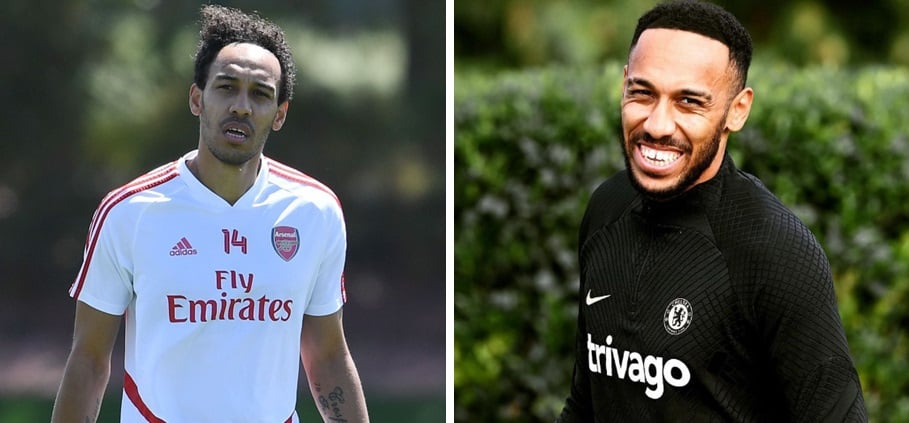
Pierre-Emerick Aubameyang gained a new look after a hair transplant. The famous star, who had a successful operation, is very happy with his new look and hair.
Many factors can affect the overall performance of a professional football player, both on the field and outside the pitch, often impacting the perception and reception of fans, the market, and the media themselves. When a player has a positive overall image, especially on the physical level, the benefits not only affect the athlete alone, in terms of earnings and privacy, but also the club and sponsors. As the results show, the implant not only positively reflects performance on the pitch and in personal confidence, but also the public’s judgment obtained an excellent result, which certainly weighs heavily on the performance and career of the athlete.
This type of operative process in this sector has shown a good result not only at an economic level, but also as an opportunity and interest from a media point of view. Overall, athletes gaining a positive overall judgment improved their reception even at the economic level in sponsorships, contracts, and the market in general. Our society today is increasingly interested in the appearance of the person, not only in the private sphere, but certainly in the context of sport, such as the discipline of football. In football, you often standardize many facades in front of media exposure and fans; in some ways, the image of a soccer player often transfers to negative and positive colleagues dependent only on results. The operations of this type can be defined cosmetically and/or psychologically: psychosomatically, because the patient is put at ease and mentally begins to have a new confidence, freeing him from criticism and mental anxieties.
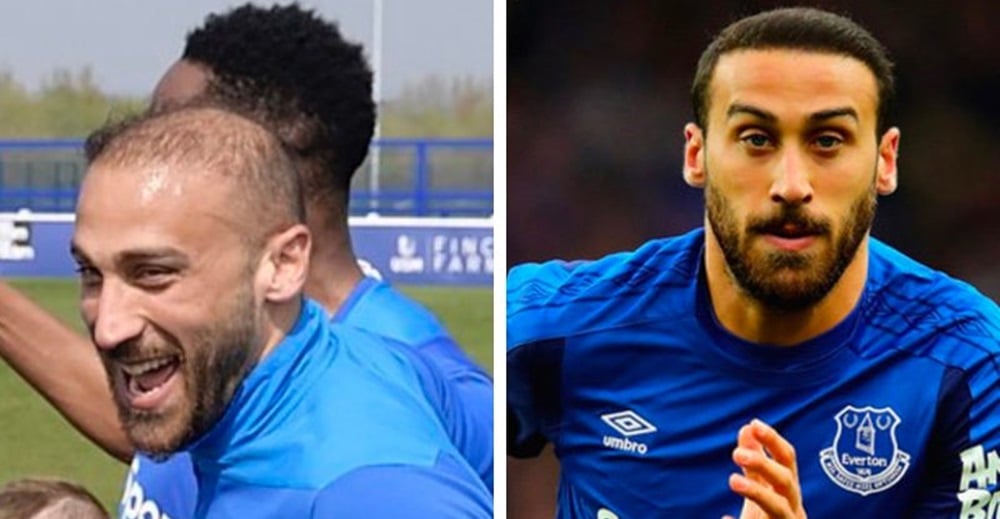
Cenk Tosun Hair Transplant Before And After
The preceding pages have shown how hair transplants are used to sustain and amplify the market value of male professional players in an industry shaped by aestheticization. A career in global professional sport requires players to be attentive to personal appearance. These two points can be linked through a shared logic: that within competitive sports, not least among footballers, personal appearance is never just a matter of aesthetics, but always of professionalism. Cosmetics, like tactics, are discursive, and a masculine sporty appearance is essential for footballers who are expected to invest in their own marketability as part of the general reliance on market values. Our interviewees themselves are rarely interested in explicit aesthetic issues, including those related to disempowerment, victimization, or objectification. Instead, hair restoration is repeatedly talked about as something that facilitates empowerment and provides a sense of feeling better and greater life chances connected to this.
While this can be read as an individual concern, the fact that hair transplants are executed within the framework of professional sport is a social and cultural concern, thereby underlining the individual narratives. Coherence and experience are two key findings that link the narratives in which the harvest of earlier hair is referred to as a kind of bank, and the reinvestment serves to promote market cruelty as football is played both on the pitch, within the frame of digital and social media, and on the hair implants and the reputational self-monitoring that comes with it. What leads us to see our narration as further backing up this, and how footballers at depressions in the bank link to hair implants, in order to promote higher market value is a story of which the fuzz in the skin marries but challenges new, temporal logics of value. The narratives outline contemporary masculinity and self-care. A footballer without hair does not disappear, but a footballer with hair reappears as an opportunity to promote a positive social and enthusiastic nature, because of the idea of hair being a ‘vital sign,’ a veritable ‘vital fluid,’ and its restoration can be thought of as tantamount to restoring their masculine vitality.
Hello!